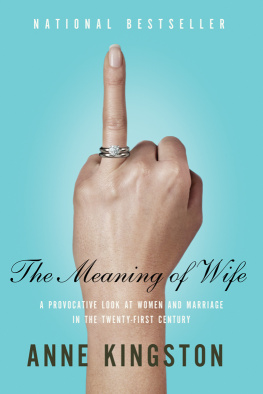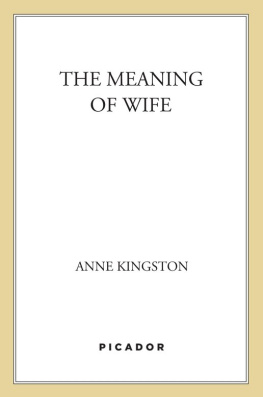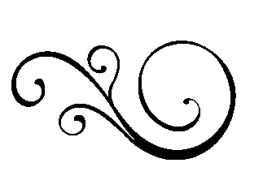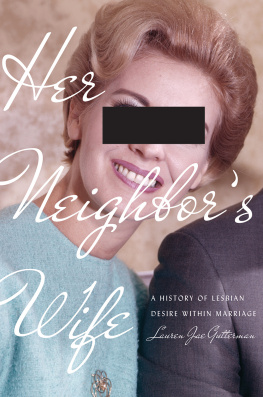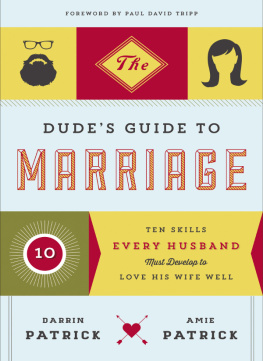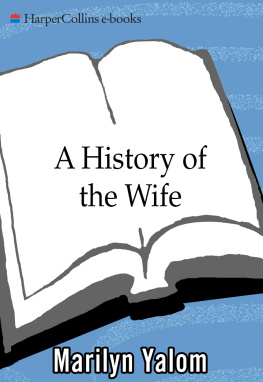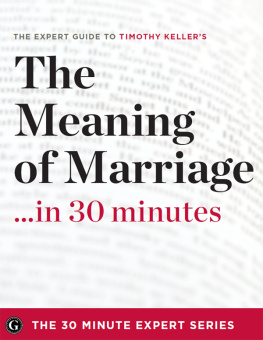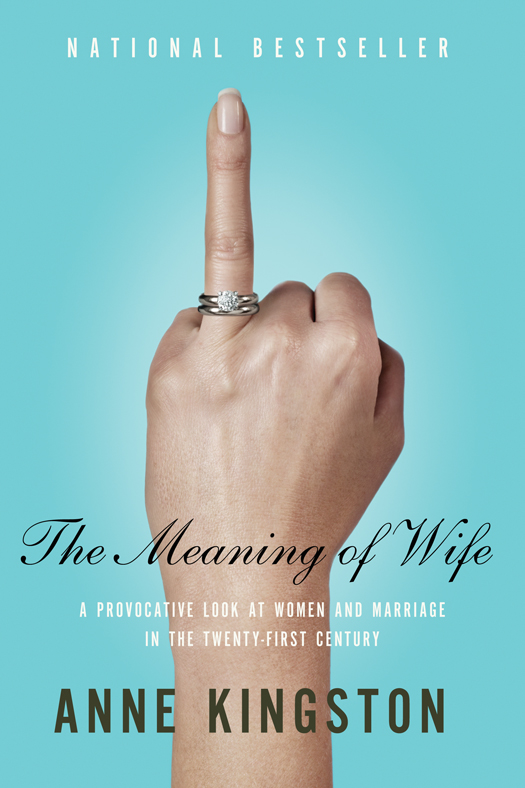THE NATIONAL BESTSELLER
An interesting and tremendously well-researched book.... Men need to read this book as much, if not more than women.
Edmonton Journal
The word wife has defined women for untold generations, but who is defining the word itself? Kingston has amassed a wealth of sociological research and tempered it with a wry wit to produce a compelling analysis of the forces behind the marriage message.
Suzanne Braun Levine, former editor of Ms. magazine
The Meaning of Wife offers important questions about the current state of relations between the sexes.
The Globe and Mail
Passionate, well-written, and intelligently argued.
Toronto Star
Billion dollar wedding industry notwithstanding, it appears that as women get more rights, both women and men need a wife, and fewer people want to be one. With insight and humor Anne Kingston analyzes the wife and reveals the many inequalities that still face women.
Jennifer Baumgardner and Amy Richards, co-authors of Manifesta: Young Women, Feminism, and the Future
A provocative and readable contribution to any debate on the future of wifedom.
Flare
Zooms in on all the right political questions.
Eye Weekly
FOR KATIE, MADELINE, CLAIRE, AND SAM,
THE NEXT GENERATION OF WIVES
We live our lives through texts. They may be read or chanted, or experienced electronically, or come to us like the murmurings of our mothers, telling us what conventions demand. Whatever their form or medium, these stories have formed us all. They are what we must use to make new fictions, new narratives.
Carolyn Heilbrun, Writing a Womans Life
Contents
Guide
O nce upon a time, a gilded horse-drawn carriage passed through the palace gates accompanied by the hard clop-clop of hooves against cobblestones and the buoyant cheers of crowds lining the streets. Inside the carriage sat a bride, veiled, an impressionistic blur.
That is my first memory of July 29, 1981, the Wedding of the Century day, the day Prince Charles married Lady Diana Spencer. I had set my alarm for four and stumbled, like millions of others, bleary-eyed in front of the television. I had been drawn by a mysterious gravitational force. Free will had nothing to do with it.
My fascination with Diana was a dark secret. I chalked it up to a synaptic misfiring. That had to be it. Otherwise, it made no sense. I was only a year older than she, and living in my first apartment, as she had been. Even so, it felt as if decades, centuries, existed between us. Marriage was on my theoretical to-do list. I didnt realize then that I was among the first generation of women able to take such a laissez-faire attitude, able to see marriage as an option, like choosing a sunroof on a new car. A few friends from university had wed, an impulse I couldnt yet relate to. Marrying meant settling, as in down.
Nor did I need princely rescue. I harbored no seed-pearl or diamond-tiara fantasies. White was not my color. Princesses, even manufactured ones, werent part of my landscape. Even so, fairy tales, even manufactured ones, can exert a narcotic effect. And, as a processed princess, Diana was central-casting perfect. She was young, barely past girlhood, while her groom was thirty-two. She was lovely, fair of hair and disposition. Her lineage was aristocratic enough. She worked in a kindergarten. Her maternal instinct was much lauded, a crucial detail, given the breeding duties required of her. Adding immensely to Dianas suitability was the fact she showed no signs of ambition for a career beyond wife. Not that anyone saw Diana becoming a wife. She was being transformed into a princess. There would be no palace drudgery for her, so we believed.
Diana was treated as a rare archeological finda nineteen-year-old virgin excavated in 1980s London. Adding a medieval touch, one of her less discreet relatives revealed that Queen Elizabeths gynecologist had examined the future princess to ensure her hymen was intact. Such creepy, retrograde details were overlooked, however, so focused were we on a fantasy custom-ordered for the modern female audience. Dianas was the ultimate before-after makeoverfrom unknown to celebrity, from pudgy teenager to sylphlike princess-to-be, from single girl to princess. But the makeover worked two ways. Diana brought to the prince and the royal family the illusion of youthful vigor.
More important, she gave the British economy a boost. Citizens, desiring a piece of the royal romance, queued up to purchase crockery and other mementos adorned with the images of the prince and future princess. Young women, entranced by Dianas story, imitated her clothing and haircut. After the engagement was announced, cheap knockoffs of her ringan eighteen-carat sapphire surrounded by diamondssold out. One New York City jeweler reported that half his customers chose similar settings in the days after the wedding.
I remember feeling slightly horrified by my giddy excitement as Diana stepped out of her carriage at St. Pauls Cathedral. This was the big moment. Not the nuptials, but the dress reveal. The bride was swaddled in cru silk taffeta adorned with thousands of pearls and sequins and boasting a twenty-five-foot court train. She presented as the ultimate confectionery, a human meringue. Inexpensive versions of the gown would be available in stores a week later so commoners could purchase a polyester version of the fantasy.
An overhead camera provided an aerial viewDianas slow procession down the aisle with her father, her train a long sliver of white against the bloody red of the carpet. Despite the pageantry, the ceremony was like all weddingsarchaic yet common: the handing-off of the bride from father to husband; the I dos of eternal fealty; the couple exiting the church, newly conjoined.
After a joyous ride through the streets of London, the Prince and Princess of Wales stood together on the balcony of Buckingham Palace. The crowd called for them to kiss. They did, a quick peck, to the delight of their subjects. Were this a true fairy tale, the story would have ended there. Nice and neat. Happily ever after. Fade to black. Production credits.
But as we know, the camera kept on rolling. Charles and Dianas wedding imagery became fractured, confused. In the next reel, the princess transmogrifies into a tragic heroine. Her veil becomes her shroud, her gilded carriage a cage. The bridal costume that so resembled an elaborate pastry can now be seen as an ominous reminder of how she would become consumed by the role. She was the quintessential product. Years later, the Vanity Fair editor Graydon Carter, commenting on Dianas commercial viability, said, When she was alive, Diana sold.
The horse-drawn carriage that transported her to her marriage morphed into a black Mercedes careering through a Parisian tunnel on the night of her death. The doting father who sat beside her on her wedding day was replaced by a louche playboy at her lifes end. Diana might have freed herself from the shackles of her marriage, but to the end she was always the passenger.
We know so much more now than we did then. We know now that the alleged Wedding of the Century was an arranged marriage fraught with feudal overtones. As the future king, Charles, who had put off marrying, needed a wife to sit beside him as queen and, more important, to provide heirs, preferably male, to the throne. So blinded were we by the mythical romance of it all that we couldnt see this was not a love match, even if the bride believed it so. We didnt see that Diana had been slotted into her position like someone sent from personnel. For a time, she did her job well, producing two sons, an heir and a spare. But then she made a fatal mistake: she didnt understand that her role, like all roles, had a script. And then, once she did understand, she chose to defy the narrative, for which she would dearly pay.

